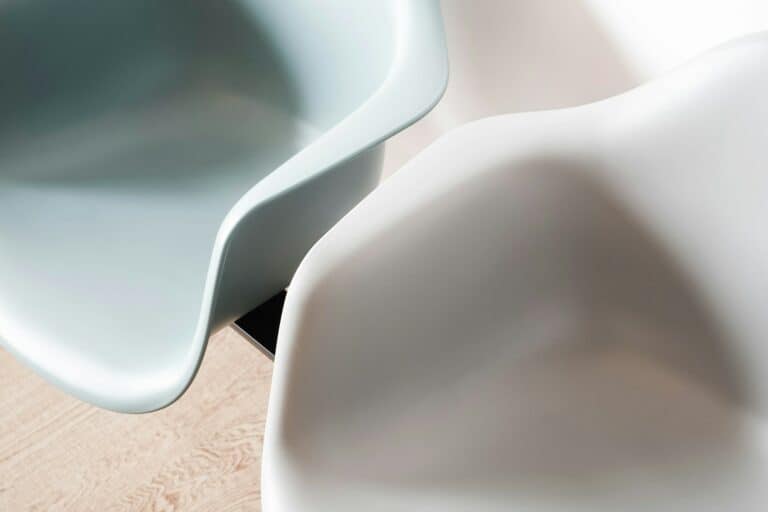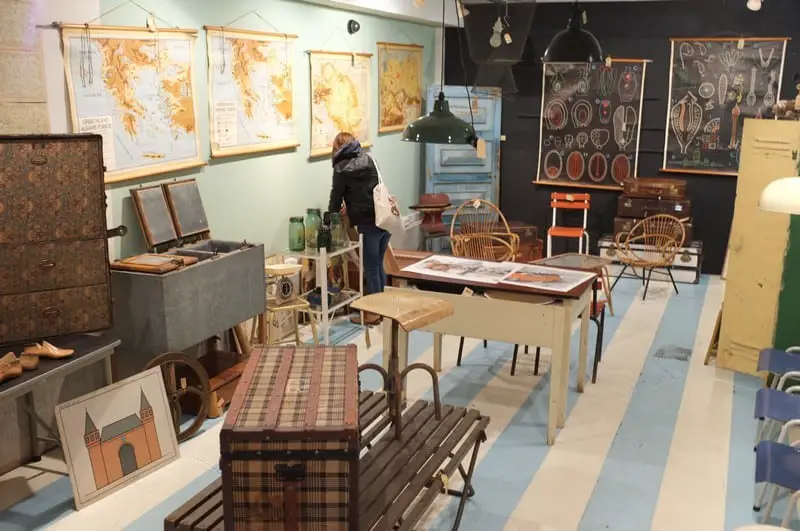In today’s digital age, there’s a veritable explosion of replicas and knock-offs of iconic design furniture! The internet is a bustling marketplace for these imitations, offering a world of choice for consumers. Online marketplaces like Amazon and eBay, as well as many top interior design retailers, have become the go-to spots for finding these amazing knock-offs. This raises an exciting question: how can design aficionados distinguish genuine masterpieces from mere copies, thereby supporting authentic creativity and fighting intellectual property infringement?
Just imagine for a moment that you come across a “DSW” chair, which is said to have been designed by Charles and Ray Eames, and it’s listed for less than €100 – what a fantastic deal! And it turns out to be a replica! With just a few keystrokes, names like Eero Saarinen, Joe Colombo, Arne Jacobsen and Gino Sarfatti flash across the screen, their legendary designs tagged with incredibly low prices!
But why is there such a huge price difference? And the answer is simple! These knock-offs are mass produced by companies in regions like the UK, where design copyright laws have historically been murky. But there’s exciting news on the horizon! The Enterprise and Regulatory Reform Act of 2013 brought UK copyright law more in line with European standards, which is great news for designers everywhere! The new law extends protection for manufactured goods for 70 years after the death of the designer, up from the previous limit of 25 years.
Despite these legislative changes, the challenge of identifying and choosing authentic pieces over copies remains. But there is hope! The ease with which replicas are distributed online can be overcome with the right guidance. Here we offer insightful guidance on how to separate the real from the fake, champion originality and uphold the legacy of iconic design.
A copy is obvious: FALSE
It’s a common misconception that it’s easy to spot a fake piece of design furniture. In fact, it’s quite the opposite. The truth is, the closer a replica is to the original, the harder it is to tell them apart. This can even leave the most experienced of eyes unsure. Intellectual property law looks at how similar two things are, rather than how different they are, when it comes to deciding whether something is a counterfeit. Basically, if someone looks at two items side by side and can’t tell them apart, then they’re probably a fake. But this can often be a bit subjective.
Can you tell the real from the fake?
It takes a keen, trained eye and lots of experience and knowledge to tell an original from a replica. E-commerce platforms selling designer furniture often make it tricky for us consumers! They use the name of the original product and the designer’s biography to make it hard to tell the difference between the real thing and a replica. They might even show pictures of the real thing instead of accurate pictures of the copies they’re selling. This makes it really tricky to know what’s what! This shows just how clever the bad guys are, and how important it is for us to be careful and make sure we’re buying the real thing. It also shows that the fight against fake designs is not only about the law, but also about making sure we’re all aware of how to spot them.
There are ways to know if a piece is an original: TRUE
A lot of people think that spotting an original designer piece from a fake is like looking for a needle in a haystack. The good news is that there are a few simple things you can look for to help you tell the difference between an original and a fake. It’s true that features like stamps, certificates of authenticity, serial numbers and even the designer’s engraved signature or logo are traditionally seen as signs of a genuine piece. It’s also worth noting that these symbols of authenticity are not invincible to sophisticated counterfeiting operations.
One of the main signs that something is fake is the price. If you see an offer that seems too good to be true, especially one that is significantly below market value, it’s best to take a closer look. If you’re looking for something specific, it’s always best to check with the official dealer network of reputable design publishers. That’s the most reliable way to verify a piece’s authenticity. Many publishers are happy to authenticate a vintage piece from photographs, which can take time and effort, but is really worthwhile. This step can stop you from losing money and wasting time on something that turns out to be a clever fake. It’s worth investing this time and effort upfront to avoid any regrets and make sure your purchase is not only a piece of design history, but also a wise investment.
All knockoffs are made equal: FALSE
The world of furniture counterfeiting is a pretty diverse place, with lots of different levels of imitation and deception, as Lionel Pithoud, director of Knoll France, explains. You can basically split counterfeits into two main groups.
The first group includes imitations that are pretty easy to spot as “cheap”. These products mislead consumers by pretending to be something they’re not. They often come under labels such as “replicas”, “inspired by” or “after XX”. They try to make you think they’re the real thing, but they’re not.
An example of a terrible imitation. Unfortunately, most fakes today are harder to tell apart from the real thing.
The second category is a bit more complex and is called “inspiration”. These items are already on the consumer market. They might look like some of the iconic pieces, but they don’t claim to be exact replicas. These items capture the essence of the originals without making a direct reference to them, which makes them a bit of a grey area in terms of design.
Even though they’re labelled differently, the price difference between the original pieces and their imitations can be huge – often as much as ten times the price. Design icons from the golden era of the 1950s and 1960s, and the work of stalwarts such as Philippe Starck, are at the forefront of this replication phenomenon.
Michel Richard, director of the Fondation Le Corbusier, has some thoughts on this trend. He sees imitation as a form of flattery or homage, but he also sees it as a problem for those who are trying to preserve the integrity and legacy of original design. This nuanced perspective on counterfeiting shows how complicated the issue is. It highlights the tension between imitation as a form of admiration and the dilution of original creative genius.
The fight against counterfeit is fierce: TRUE
The fight against fake design furniture is tough and never-ending. Design publishers are always on the lookout, trying to catch fake replicas. They use a lot of different tactics to fight counterfeiting, including keeping a close eye on things, seizing fake goods, stopping them from being sold, destroying fake stockpiles and trying to get compensation for the damage done. It’s like a never-ending battle to shut down counterfeit websites. It’s like the mythical Hydra, where for every site that is taken down, two more spring up in its place.
But the anti-counterfeiting strategy goes beyond mere suppression. “To stay ahead of the counterfeiters, you have to innovate constantly,” explains Gianluca Armento, CEO of Cassina. This is a philosophy that many design publishers share. They use their creative and legal rights to innovate. They work with the descendants of the original designers, copyright holders and dedicated foundations. They not only preserve the legacy of classic designs, but also enhance it through refined details, fresh colour schemes and the use of cutting-edge materials. They do this while remaining faithful to the designer’s original vision.
Education is also an important part of this battle. Isabelle de Ponfilly, who was CEO of Vitra between 1998 and 2021, says it’s important to educate the public about the value of owning original pieces instead of fakes. Many publishers, either together or on their own, have launched educational campaigns to encourage people to appreciate original design. These initiatives are about more than just protecting designs. They’re also about creating an environment where original creations are valued and celebrated. That way, we can make sure that the legacy of iconic designs is preserved for future generations.
There is no risk to buy a knockoff: FALSE
The belief that there are no consequences for buying a fake is a dangerous misconception. At its core, a fake is a counterfeit, which makes it not only unethical, but downright illegal.
The implications of such purchases extend far beyond the initial transaction. When counterfeiting operations are uncovered, it’s not just the manufacturers who are in legal jeopardy; consumers can also be accused of “concealing a counterfeit”. The consequences can be severe, including up to three years’ imprisonment, fines of up to €300,000, customs sanctions and other penalties.
Opting for a seemingly budget-friendly counterfeit version of a design product therefore carries significant legal and financial risks. It’s a stark reminder to tread carefully and consider the wider implications of choosing a counterfeit item over an authentic piece, and underlines the importance of making informed and legal choices in the world of design.
A knockoff is cheaper: TRUE
It’s a simple fact: copies are cheaper, but that often means they’re not as good. It’s pretty simple: if you cut costs, you’re going to have to cut corners on the quality of materials and craftsmanship. How else could replicas be offered at a fraction of the price of the real thing without making any compromises?
Also, true design pieces should be seen as more than just pieces of furniture. They should be seen as tangible investments. The best designs are made with the best materials and by experts. They’re not just for today; they’re for tomorrow too. They’re heirlooms that can be passed down through generations, even if they lose a bit of their value, because they’re still worth more than they cost. Imitation is simply that: imitation. It’s not authentic and it doesn’t last. So, it’s basically worthless unless it’s being used for something specific. Unless it’s meant to be blown up in an action movie, of course. Basically, investing in fakes is like burning money.
Jaime Gillin sums this up perfectly in “The Real Cost of Rip-Offs”, pointing out that authentic designs are indeed investments. Yes, they cost more upfront than knock-offs, but they’re made with the best materials, designed to last for generations and even increase in value over time. On the other hand, knock-offs don’t last as long. They’re made with lower-quality materials like foam, fabrics, metals, and joinery techniques, so they wear out quickly. This shows the long-term value and sustainability of choosing original designs over short-lived replicas.
The Bottom Line
If you’re looking for a particular piece of design but your budget doesn’t quite match up, there’s no need to settle for something less than perfect. There are loads of genuine, vintage mid-century pieces out there just waiting to be found on sites like eBay, Craigslist and at estate sales. These sites often let you buy verified originals at prices that won’t break the bank, so they’re a great, legit way to get what you want without risking your money on a fake.
Ultimately, the choice between an authentic piece and a counterfeit is no different to choosing between a real Hermès bag and a fake one. While it might not be obvious to anyone else, you know whether it’s the real deal or not. Even if it looks like the genuine article, a fake is still a fake. The value of an original isn’t just about how it looks or how well it’s designed. It’s about the history and authenticity that it brings to your space. And that’s what makes it cool.



